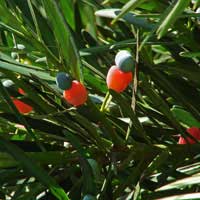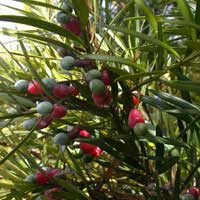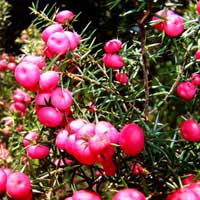 Full List of Fruits
Full List of Fruits  Emu berry
Emu berryEmu berry
Scientific name - Grewia retusifolia
Emu berry, binomially known as Grewiaretusifolia, is a shrub specie belonging to the family of Malvaceae. This tree holds its native to Australian regions in the areas of Kimberley across Kakadu, Arnhem Land, the Gulf country, Cape York and down to the Tropic of Capricorn. This tree grows up to look like a bushy weed like plant. During the months of April to September this tree bears berries along its stems.
Popularly known as emu berry this fruit is a tiny berry like fruit that has a sweet taste to it. It is also known with other names such as Dysentery Bush, Emu-berry, Dog's Balls, Turkey Bush and Diddle Diddle, G. retusifolion.
Consumption of the entire plant crushed and boiled will result in relieving cold, fludiarrhoea and even to bathe sore eyes.
Emu berry grows like any other shrub as tall as 1 to 3 meters tall. This multistemmed shrub starts to form clumps after growing a few meters tall. The bark of the tree is thin and fibrous, that appears in shades of green turning red brown in color. Stellate hairs begins to appear on younger twigs and petioles. The stems bears leaves, and the leaf blades grow 4-5 x 2.5-2.7 cm.
This tree can be mainly be seen on lowlands of jarrah and Karri. They are also found in forest with sandy soils and are widely spread by root suckering. It can grow at an elevation of 120 - 80 meters above sea level. The most suitable temperature for its vegetation is an average of 15.6°C, the lowest temperature it can drop to is minimum in the coldest month of 7.2°C, and it requires rainfall of mean annual precipitation of 1011 mm.
![]() Nutritional Value of Emu berry
Nutritional Value of Emu berry
| Total Fat | 0.8g | 1% |
| Saturated Fat | -1g | -5% |
| Cholesterol | -1mg | -0% |
| Sodium | 27mg | 1% |
| Total Carb | 22.3g | 7% |
| Dietary Fiber | 34.4g | 138% |
| Sugars | -1g | |
| Protein | 3.8g | 8% |
| Vitamin A | -0% | |
| Vitamin C | 7% | |
| Calcium | 41% | |
| Iron | 33% | |
Emu berry has many health benefits attached to it. The use of roots and leaves of this small shrub to treat variety of disorders including diarrhea, headache, fatigue, boils, infected sores and scabies is something that the locals have been practicing from age old days. Uveitis an eye inflammation can also be treated by the use of decotion of the plant. This fruit is known to house good source of calcium, sodium, dietary fiber, iron and vitamin C. problems such as analgesic, antirheumatic, antiseptic, antidysentric, antiulcer and purgative problems can be kept at bay if one religiously consumes and adds emu berries in their day to day diet.
The berry has long been used in traditional medicine to treat a variety of ailments, from headaches to stomach problems. It is believed to have antibacterial and antiviral properties, and is used to treat colds and the flu. It is also believed to help reduce fever and to stimulate the immune system.
The emu berry is an excellent source of dietary fiber, which helps to improve digestion and reduce cholesterol. It is also a good source of Vitamin C, which helps to protect cells from free radical damage. The berry is also a good source of calcium and iron, which help to maintain healthy bones and teeth.
The emu berry is a tasty, nutritious, and versatile fruit that is packed with health benefits. It is an excellent source of dietary fiber, vitamins, minerals, and essential fatty acids, and its anti-inflammatory properties can help reduce the symptoms of arthritis and other inflammatory conditions. It is also a good source of iron and calcium, which help to keep the body healthy. Whether eaten raw, cooked, or juiced, the emu berry is a wonderful addition to any diet.
Harvesting of emu berry is a labor-intensive process that requires a lot of skill and patience. It is done by hand during the summer months, when the fruits are ripe. The trees must be harvested when the fruits are mature and the leaves are still green. This is to ensure that the fruits are of the highest quality and taste.
The first step in harvesting the emu berry is to cut the tree down to its base. This is done with a sharp axe or a chainsaw. The trunk is then cut into logs, which are then transported to the harvesting site.
Once at the harvesting site, the logs are cut into smaller pieces and stacked. The fruits are then picked from the logs and placed into buckets or bags. The fruits must be picked carefully to avoid damage to the flesh and seeds.
The harvested fruits are then washed and sorted according to size and quality. The best-quality fruits are placed into containers and stored in a cool, dry place until they are ready for sale.
Emu berry is a popular ingredient in many dishes, including jams, jellies, pies, cakes, teas and juices. In some parts of Australia, the fruits are dried and used to make a type of flour. The fruits can also be eaten raw or cooked.
Emu berry is a highly valued fruit, as it contains many health benefits. It is a good source of dietary fibre, protein, iron, calcium and vitamins A and C. It is also known to help reduce inflammation and boost the immune system.
Harvesting of emu berry is an important industry in Australia. It provides employment and income to thousands of people, and helps to conserve the environment by providing a sustainable source of food.
Harvesting of emu berry is a complex process that requires a lot of skill and patience. It is a process that has been perfected over the centuries, and is still being practiced today. The fruits of this hardy tree have been providing nutrition, health benefits and sustenance to the people of Australia for centuries, and will continue to do so for many years to come.


















